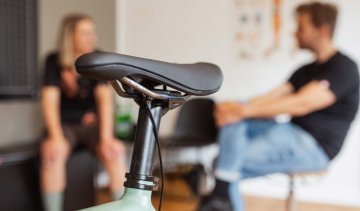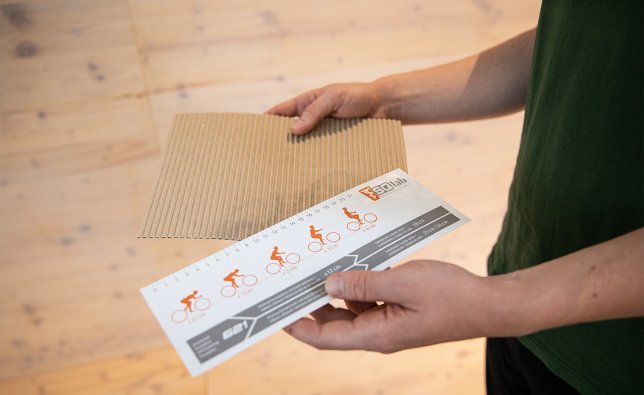
Product test: Thermoformable bike saddles from ...
A bike saddle that adapts to your anatomy? We have tested the thermoformable saddles from REFORM for you, which promise exactly that.
We’ll give you tips and advice on the right saddle for your touring bike, so that your bike tour doesn’t become a headache.
You might know the problem: even the most beautiful bike tour becomes a torturous slog when your butt starts hurting after a few kilometres. In many cases, the reason for this is an incorrect saddle. You will find plenty of good tips and great advice for a new saddle, but: every butt is different and feels comfortable on a different saddle. If someone recommends a super comfortable saddle, it only says that it is good for that person. This does not mean that it is the best saddle for you. This is why the question is even more important: Which comfort saddle suits you best? We’ll give you tips on how to find the right saddle for you and your bike.
Posture is a decisive criterion when choosing a saddle. On a touring and city bike, you sit more upright than on a sportier bike. As a result, there is more weight placed on the buttocks than on a mountain bike or road bike. As a result, you need a wider saddle, as this distributes pressure across your butt better. Roughly speaking, the more upright you sit, the wider the saddle should be. Therefore, you must first and foremost think about what you use your bike for, where you intend to ride, etc. By the way, we have put together individual guides on choosing saddles for sports bikes, both for road bikes and mountain bikes.
Another important criterion: the sit bone distance. It is wrong to think that a wide backside automatically necessitates a wide saddle. What’s actually a much bigger factor is the distance between the sit bones, which is not visible from the outside. To be on the safe side, you can determine your sit bone distance with the help of a simple measuring cardboard, like the one offered by SQlab. The number in combination with what you intend to use your bike for will help you to determine the right saddle width. SQlab itself recommends that you add another ten to 40 millimetres to the measurement, depending on your posture. Basically, if your sit bone distance falls exactly between two sizes, you should opt for the wider version if you have a more upright posture.
You can find out more about this in our overview text on saddle ergonomics.

The SQlab measuring cardboard lets you easily determine your sit bone distance: © bc GmbH & Co. KG
The sit bone distance is not only decisive for determining your saddle’s width, but also for figuring out what type of padding (if any) you need. A comfort saddle, as the name suggests, provides a comfortable ride that is fun and enjoyable. This is primarily, of course, due to the padding, which is mostly made of gel. The padding should be in the area of the sit bones. They ensure an ideal distribution of pressure, and that the sit bones rest optimally on the bicycle saddle. These types of saddles are particularly popular for urban use. On a touring bike, on the other hand, you can also use a MTB- or road bike saddle. Microfibre fabric is standard for the surface material of a comfort saddle. Ergon uses an additional core with BASF Infinergyin its Prime models, which is also used in running shoes. The complementary material layer adapts to the natural movements of the pelvis for increased comfort. Alternatively, bend leather saddles from Brooks or Contec are also available. In this case, leather not only serves as an upper material, but is also a core component. Bend leather saddles have the advantage of adapting to the fit of the buttocks after a break-in period. The individual comfort a bend leather saddle has to offer is not to be underestimated. During the break-in period, the saddle surface can be relaxed with the help of a special tensioning wrench or, conversely, can also be re-tensioned. Steel is usually used for the saddle rails on comfort saddles. The material is very stable, durable and inexpensive, and unlike in the sports sector, shooting for the lowest possible weight is not much of a priority. However, there are of course models with carbon- or titanium saddle rails for touring, if weight is still a factor for you.
A soft saddle offers a lot of comfort, but the assumption that it is necessarily the best choice is wrong. Riders who sit on too soft of a surface suffer more often from posture problems than others. The reason is the unfavourable distribution of pressure. Saddle material that is too soft shifts pressure more outwards so that the distribution is no longer directly under the sit bones. Over time, this can lead to a lot of pain. A harder saddle in combination with padded trousers and chamois cream, as used by professional athletes, is usually the better choice, especially if you often ride over longer distances. If, on the other hand, you intend to use your new saddle for short daily commutes and don’t want to change into cycling clothes, the softer saddle compound may be the better fit in the long run. However, it is important that you do not combine two kinds of padding. In every case, this leads to the development of extremely unpleasant pressure points.
Saddles with a recess are becoming increasingly popular. The cutout may seem a little odd at first glance, but it has a purpose: the so-called relief channel prevents numbness and discomfort. It prevents the nerve tracts and blood vessels from being squeezed too much, especially in the perineal area between the saddle and the pubic bone. If you often feel pain in this area, a saddle with a cutout could help you. Even classic leather saddles such as the B17 Imperial from Brooks are now available in versions with a cutout. To avoid any misunderstanding: a cutout in the saddle in no way means that it is by definition a women's model.
Do women need different saddles than men? Several studies have already investigated this question, and the results are contentious. Manufacturer Ergon, for example, takes the position that women need their own saddles. Due to the specificity of the pelvis, women suffer more often from complaints in the genital area, while men experience more pain in the perineal area. Therefore, the relief channel and gel padding would have to be placed in different areas on women’s models than on men's models. On the other hand, manufacturers like SQlab argue that there is no need for differences between men's and women's models. Only the sit bone distance and the riding position are decisive for comfort. Their saddles are therefore unisex models. You can determine what is right for you by finding the saddle that suits you best. Men can also be happy with a women’s model, or maybe a solution lies in the unisex saddle, which many manufacturers offer as a supplement to their gender-specific models.
E-bikes are enjoying a boom in popularity. That said, hardly surprising that there are now special E-bike saddles on the market. These feature a raised back to prevent slipping on climbs and when accelerating. In addition, some products also have a carrying handle to make it easier to lift the E-bike.
Saddles with built-in suspension, which is sometimes the case with leather saddles, for example, have the advantage that they follow the pedalling movement when cycling thanks to the tension and compression coils. This takes pressure off the spine and intervertebral discs. Shocks are also reduced, and the coccyx is relieved. A saddle with suspension is therefore particularly suitable if you have problems with your back. Be aware, however: if you’re travelling with a kids seat, little ones can get their fingers caught in the spring. Alternatively, if you suffer from lumbar problems, you can also install a suspension seatpost. Here you’ve got two possible options: telescopic and parallelogram seatposts. SQlab offers an alternative concept: their Active series saddles come with specifically flexible saddle rails, which are complemented by replaceable elastomers that can be adjusted to the rider's weight.
No matter which saddle you decide on in the end, always remember: getting used to it takes time. Your derrière is made up of muscles that need to be exercised. New stresses can be unpleasant at first, and cycling is not possible without pressure on the buttocks – it’s just physics, plain and simple. It is therefore perfectly normal if your butt hurts a little during the first few tours. If you don’t have the wrong saddle, you’ll get past it over time. The right saddle is a product specific to every individual. Only you can decide if you are happy with it, and if you’re riding with the right settings.
Rain, snow and cold weather can take their toll on a saddle over the long run. Therefore, it makes sense to use a waterproof saddle cover for protecting it, allowing you to enjoy a dry saddle after a rain shower. For leather saddles, special leather conditioners and treatments are also recommended to keep the saddle surface smooth and supple for a long time. What’s also handy to have are small saddle bags, which can be used to store small items such as mini-tools, keys or a spare tube. However, please make sure beforehand that your saddle can accommodate a bag. Most of the time, saddles have a universal mount, but there are always exceptions.